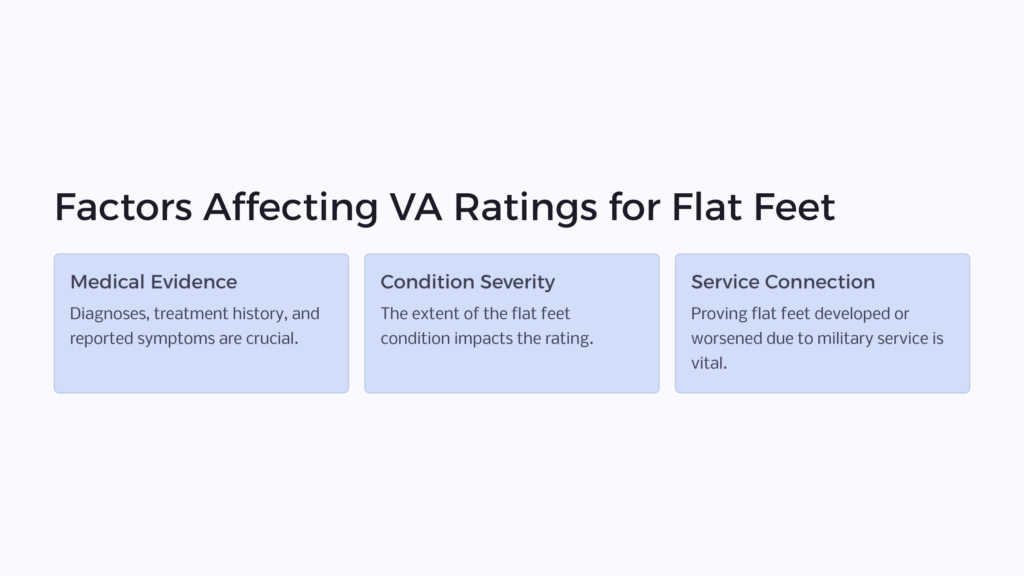Veterans Affairs (the VA) uses a rating system to determine the degree of disability for veterans, which consequently impacts their benefits. Flat feet, or pes planus, is a medical condition that veterans often encounter. This article will shed light on this condition, the VA rating system, how it applies to flat feet, and how you can find yourself eligible for disability compensation.
What is Pes Planus?

Flat feet, known medically as pes planus, is a condition wherein the arches on the inside of the feet are flattened, thereby allowing the entire soles of the feet to touch the floor when standing. It’s normal for infants and toddlers to have flat feet, but as they get older, their feet should develop arches. However, some people never develop arches, leading to flat feet in adulthood. This is often seen as bilateral flat feet, where both feet are affected. Others may develop it as a secondary condition as they age or after an injury. Pes planus following a foot injury will be localized to the injured foot.
The causes of this foot deformity may range from genetic factors, prolonged physical stress, injuries to the foot or ankle, certain diseases like rheumatoid arthritis, and even from the normal aging process. Obesity, diabetic nerve damage, or pregnancy may also cause flat feet.
Understanding VA Disability Ratings
In essence, VA ratings aim to quantify veterans’ disabilities resulting from their military service. These ratings range from 0 percent to 100 percent, stepping up in 10% increments. The VA assesses the severity of a veteran’s disability and assigns a percentage. This percentage will then determine the amount of compensation the veteran will receive. The higher the rating, the more significant the disability, causing the veteran to receive a larger compensation.
Rating disabilities is a big part of what the VA does for its disabled veterans, as a rating correlates to VA benefits, and plays a significant role in a veteran’s life. A disability rating often dictates the quality of life post-service. Given the importance of these VA ratings, understanding them is vital for every veteran.
Typical VA Rating for Flat Feet

When it comes to flat feet, the VA uses diagnostic code 5276 (acquired) and also diagnostic code 5277 (congenital) to denote this condition. The VA assigns a rating based on the severity of the condition; for example, a severe bilateral flatfoot condition might receive a 30% disability rating, while mild symptoms might warrant a 10% rating.
The VA offers disability benefits for flat feet, considering whether the veteran experiences pain and foot problems, whether it affects their ability to work or other daily activities, and the degree of deformity of the foot.
Factors affecting VA Ratings for Flat Feet

Several factors come into play when assessing the VA rating for flat feet. One key element is the medical evidence provided, including medical diagnoses, treatment history, and the reported symptoms.
The severity of the condition and the connection between the condition and the veteran’s service are also vital considerations. If a veteran can provide evidence to prove that their flat feet developed or worsened because of their military service, they may receive a higher disability rating.
How to Apply for VA Disability for Flat Feet

To apply for a VA disability rating for flat feet, the veteran should begin by visiting a healthcare provider for a diagnosis and evaluation of the condition. The veteran will then need to provide medical records showing their diagnosis, treatments, and reported symptoms along with their application. Further, they’ll need to include documents demonstrating that their flat feet are connected to their military service. This should hopefully ensure that their flat feet VA rating is high enough to warrant VA disability benefits.
Finding Success in VA Disability Claim for Flat Feet
Firstly, comprehensive medical records are important. These should include all diagnoses and treatments related to flat feet. The presence of these documents can significantly improve the chances of success.
Secondly, the counsel of a lawyer or a VA-accredited agent can help guide veterans through the process. Their expertise can help in building a stronger case.
Additionally, testimony from fellow service members or others who can bear witness to the veteran’s condition and its impact on their life can also be incredibly beneficial.
Understanding the VA ratings for flat feet is essential for veterans suffering from this condition. It can mean a significant difference in the quality of life post-service. Therefore, do not shy away from seeking help and taking the necessary steps to make a VA disability claim. Take our quiz at Benefits.com today.
 Benefits.com Advisors
Benefits.com Advisors
With expertise spanning local, state, and federal benefit programs, our team is dedicated to guiding individuals towards the perfect program tailored to their unique circumstances.
Rise to the top with Peak Benefits!
Join our Peak Benefits Newsletter for the latest news, resources, and offers on all things government benefits.




















